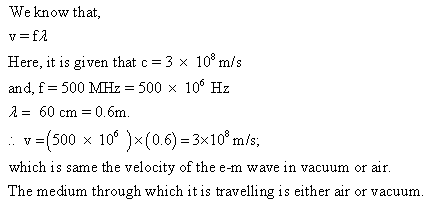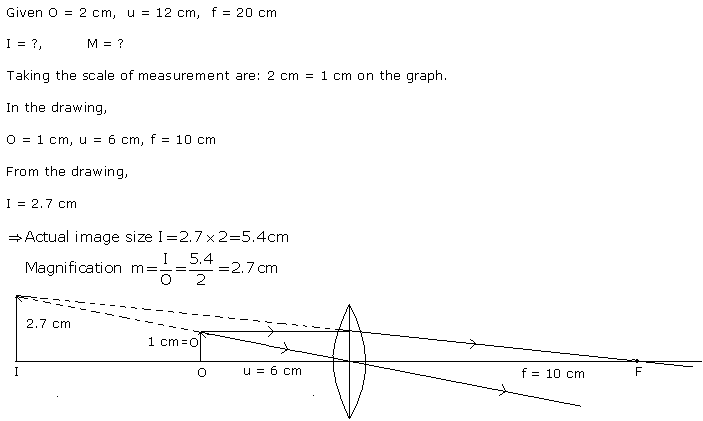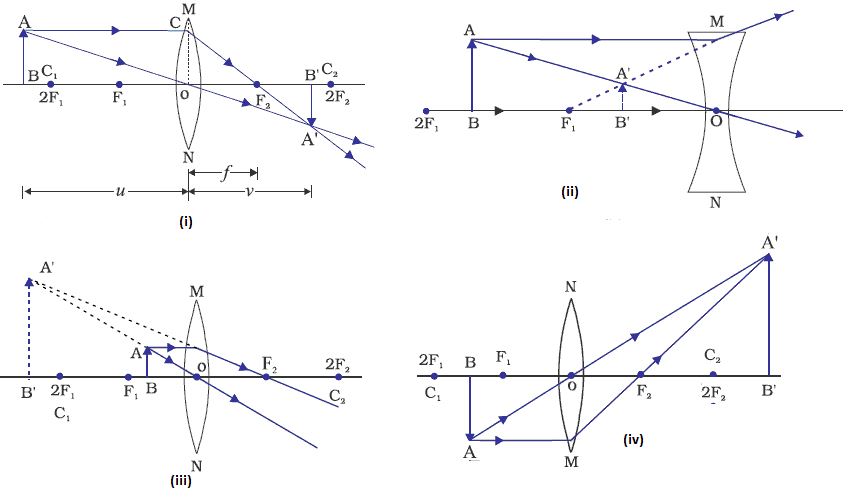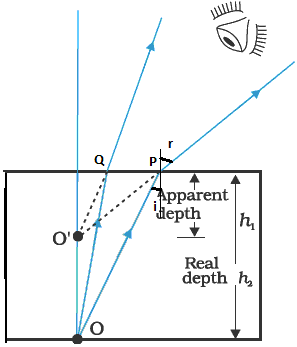Class 10 FRANK Solutions Physics Chapter 2 - Light - Exercises and MCQ
Study Frank Solutions for ICSE Class 10 Physics Chapter 2 Light Exercises and MCQ. Practise drawing different kinds of ray diagrams. Learn to create a ray diagram to explain the formation of an image through a magnifying glass. Revise Physics problems related to the characteristics of light. Also, read the accurate answers for important chapter-specific MCQs by expert teachers.
TopperLearning’s ICSE Class 10 Physics study materials such as concept videos, sample papers and Physics practice tests are easily accessible on our portal 24/7. Other than learning materials, we also have a huge collection of Physics doubts and solutions which you can use to effectively understand the concepts in your syllabus.
Light - Exercises and MCQ Exercise 112
Solution 1
(v) less than one focal length
Ans1(b)
(iii) inverted and magnified.
Ans1(c)
(E) (i), (ii) and (iii)
Ans1(d)
(D) (ii) and (iii) only
Ans1(e)
(ii) real
Ans1(f)
(ii) virtual, erect, diminished
Ans1(g)
(v) Both the images are real and inverted.
Light - Exercises and MCQ Exercise 113
Solution 5
Solution 2
(a) Principal focus: Rays of light can pass through the lens in any direction and hence there will be two principal foci on either side of the lens and they are referred to as the first principal focus and the second principal focus of a lens.
First Principal Focus (F1)
It is a point on the principal axis of the lens such that the rays of light starting from it (convex lens) or appearing to meet at the point (concave lens) after refraction from the two surfaces of the lens become parallel to the principal axis of the lens.
Second Principal Focus (F2)
It is a point on the principal axis of the lens such that the rays of light parallel to the principal axis of the lens after refraction from both the surfaces of the lens pass through this point (convex lens) or appear to be coming from this point.
(b)
Solution 3
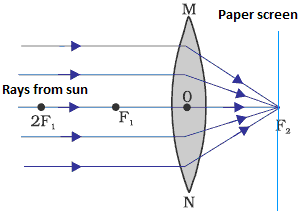
(b)
(i) Rays from sun can be regarded as parallel rays.
(ii) The point is called 'Focus'.
(iii) A convex lens is used to focus the sun rays on a piece of paper to burn a piece of paper. A large amount of heat gets concentrated at a point and is sufficient to burn the piece of paper.
Solution 4
(b) A simple magnifying glass forma a virtual, erect and magnified image of a tiny object which is distinctly seen by the eye because the eye lens converges the rays to form a real image on the retina.
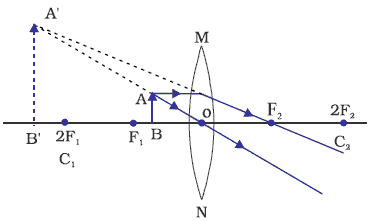
Ray diagram for the formation of image by a magnifying glass.
Light - Exercises and MCQ Exercise 114
Solution 6
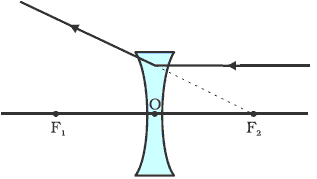
Solution 7
(b) Accommodation is achieved with the help of ciliary muscles.
To focus the distant objects, the ciliary muscles are relaxed causing the eye lens to become thin and thus increasing the focal length of the eye lens.
To form the image of a near object on the retina, the ciliary muscles contract and thereby pull the ends of the choroid closer. Thus, the eye lens thickens to shorten its focal length and converges the rays to form the image.
In this manner, by changing the focal length of the eye lens, the image of the objects at different distances is brought to focus on the retina.
(c) A converging lens of suitable focal length is used in the spectacles worn by an old lady for knitting.
Solution 8
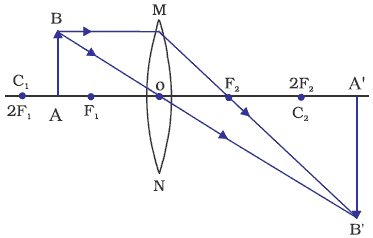
Solution 9
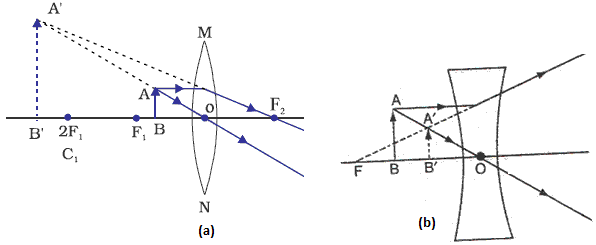
(b) In both the cases the image formed is virtual, upright and on the same side of the lens but the image formed by a convex lens is magnified and that formed by a concave lens is diminished.
Solution 10
Light - Exercises and MCQ Exercise 115
Solution 11
(b) Radiations B (microwaves) have a higher frequency.
(c) Common properties of e-m spectrum:
(i) All electromagnetic waves travel with the same speed in vacuum (or air) which is equal to the speed of light i.e. 3 x 108 m/s.
(ii) These waves are unaffected by the electric and magnetic fields.
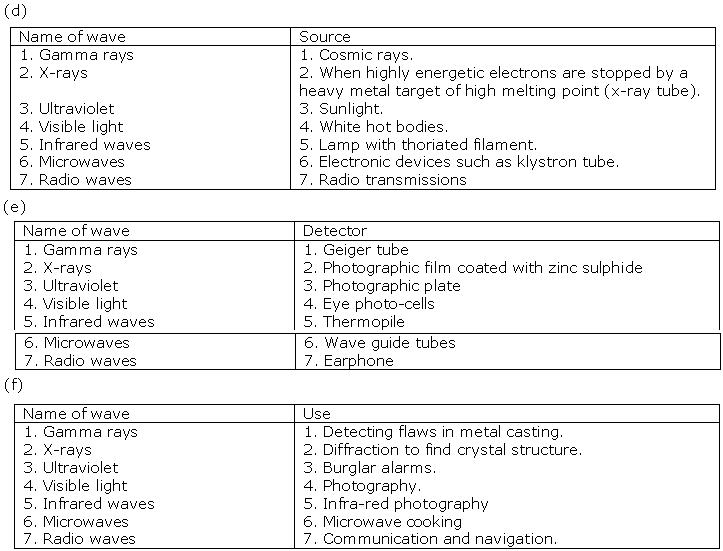
Solution 12
Frequency = velocity/ wavelength
Thus,
n = v/λ
n = 3 x 108/ 6 x 10-7
n = 5 x 1014 Hz
Solution 13
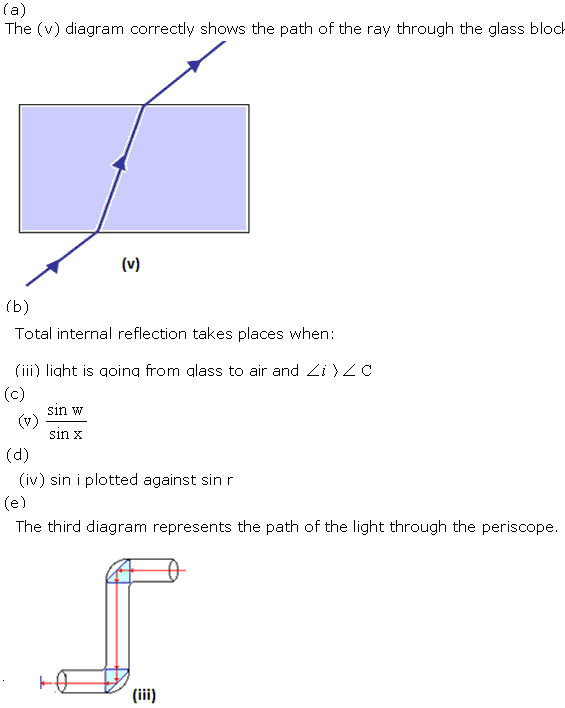
Light - Exercises and MCQ Exercise 116
Solution 14
(i) Angle of incidence (i) of ray OP is marked in the above diagram.
(ii) Angle of refraction (r) of ray OP is marked in the above diagram.
(iii) The position of image of the object (O') as seen from above is marked in the diagram.
(iv) An approximate path of ray OQ is shown in the above diagram.
(b) Water is a denser medium as compared to air; so on passing from water (denser) to air (rarer) the speed of light of light increases and it bends away from the normal.
(c)
Refraction is the bending of light as it passes from a medium of one optical density into a medium of a different optical density, as from air to water or water into air. The amount of bending is dependent upon the incident angle of the light. In the diagram below, a light ray, "A" strikes the water at right angles and passes through the surface without bending. But as the incident angle decreases (becomes less than 90 degrees) the light bends more and morerays "B" and "C." Light striking the surface parallel to the surface, bends downward.
Since light is coming into the water from all directions, refraction creates a cone of light with its base on the surface and its apex at the fish's eye. The base of the cone is a circular opening at the surface through which the fish sees the entire outside world. This opening is called the "Fish's Window". Only the light passing through the window enters the fish's eye. Notice line "D," It's a ray entering the water beyond the window; refraction bends it such that it cannot reach the fish's eye.
Solution 15

Light - Exercises and MCQ Exercise 117
Solution 16
Total internal reflection: It is an optical phenomenon that occurs when a ray of light strikes the boundary of denser medium at an angle greater than the critical angle w.r.t. the normal of the surface; this ray is then totally reflected back into the denser medium.
The two necessary conditions for total internal reflection to take place are:
1.The light ray must proceed from denser to rarer medium.
2. Angle of incidence in denser medium should be greater than the critical angle for the pair of media in contact.
Solution 17

Solution 18
(b) Red colour at X and violet colour at Y.
(c) Above X, we would detect infra-red radiation and below Y, ultra-violet radiation.
Light - Exercises and MCQ Exercise 118
Solution 19
1. Ultraviolet radiation can pass through quartz, but they are absorbed by glass.
2. They are usually scattered by the dust particles present in the atmosphere.
Solution 20
1. They travel in straight lines as light does, with a speed equal to 3 x 108 m/s in vacuum.
2. They obey laws of reflection and refraction.
3. They are unaffected by electric and magnetic fields.
Two properties of infrared radiation different from the visible light:
1. They are absorbed by glass, but they are not absorbed by rock-salt.
2. They are detected by their heating property using a thermopile or a blackened bulb thermometer.
Solution 21
Waves B are infrared radiations.
In vacuum, both travel with the same speed. Hence, the ratio of their speeds is 1:1.
Solution 22 (a)
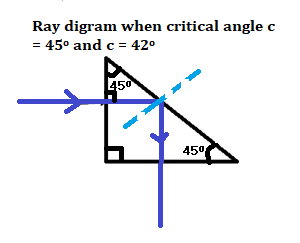
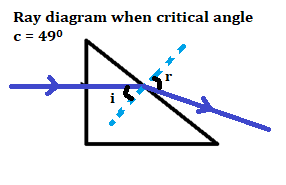
Solution 22 (b)
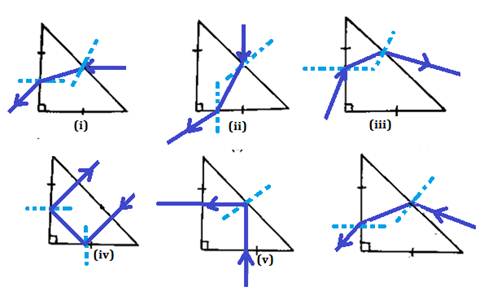
Solution 23
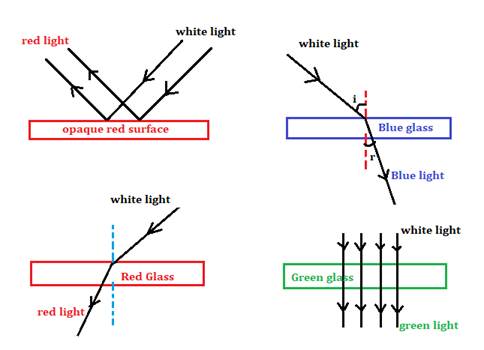
Light - Exercises and MCQ Exercise 119
Solution 24
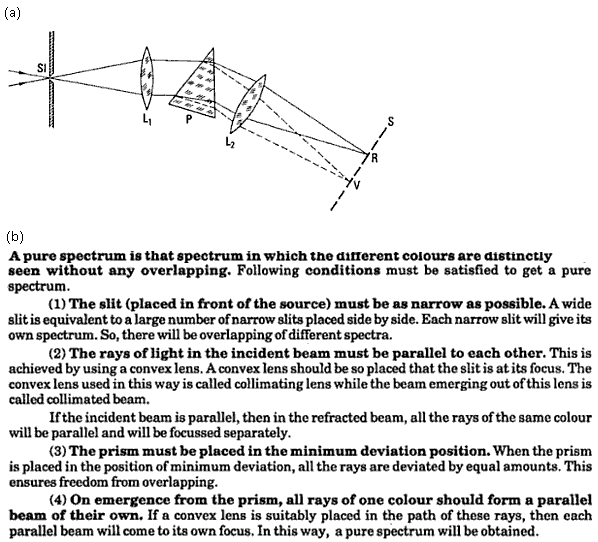
Solution 25
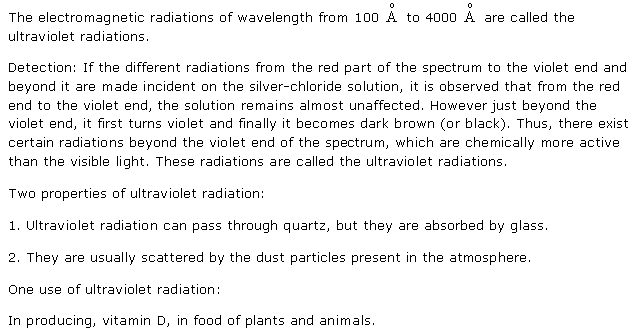
Solution 26
1. They travel in straight lines as light does, with a speed equal to 3 x 108 m/s in vacuum.
2. They obey laws of reflection and refraction.
3. They are unaffected by electric and magnetic fields.
Solution 27
